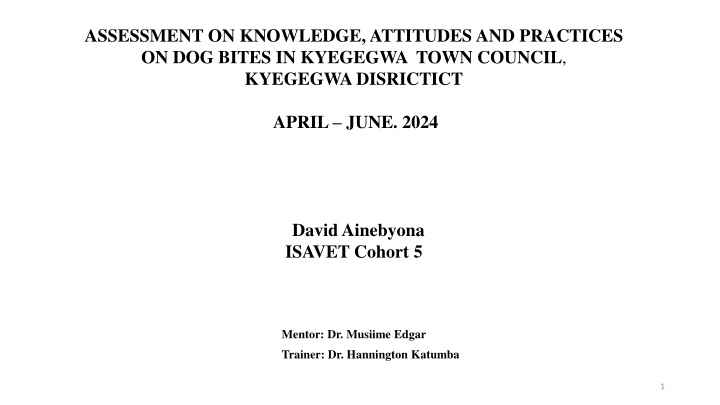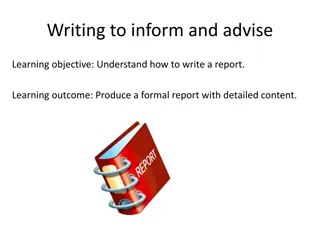
Knowledge, Attitudes, and Practices on Dog Bites in Kyegegwa Town Council
Explore the assessment on knowledge, attitudes, and practices regarding dog bites in Kyegegwa Town Council, Kyegegwa District, focusing on the threat of rabies transmission and the need for informed decision-making and awareness campaigns.
Download Presentation

Please find below an Image/Link to download the presentation.
The content on the website is provided AS IS for your information and personal use only. It may not be sold, licensed, or shared on other websites without obtaining consent from the author. If you encounter any issues during the download, it is possible that the publisher has removed the file from their server.
You are allowed to download the files provided on this website for personal or commercial use, subject to the condition that they are used lawfully. All files are the property of their respective owners.
The content on the website is provided AS IS for your information and personal use only. It may not be sold, licensed, or shared on other websites without obtaining consent from the author.
E N D
Presentation Transcript
ASSESSMENT ON KNOWLEDGE, ATTITUDES AND PRACTICES ON DOG BITES IN KYEGEGWA TOWN COUNCIL, KYEGEGWA DISRICTICT APRIL JUNE. 2024 David Ainebyona ISAVET Cohort 5 Mentor: Dr. Musiime Edgar Trainer: Dr. Hannington Katumba 1
Background Dog bites are most important source of rabies virus infection to humans, livestock and wildlife (Kankya et al., 2022), With 99% of human infection being from Dog rabies that pose a threat to 3.3 billion people worldwide (Knobel et at., 2005) Rabies is a major zoonotic disease threatening Global public health, and rabies virus is transmitted to humans through a bite (Organization, 2018, 2019b) 2
contind.. Rabies is caused by Rabies Virus of family Rhabdoviridae(Masiira et al., 2018) and virus is transmitted to humans through a bite and of all human cases, up to 99% are acquired from the bite of an infected dog (Organization, 2019a) Causing 55000 human death annually with Asia and Africa being worst affected (Monje et at., 2020), In Uganda 486 human rabies death occur every year with 13900 Dog bites registered from 2001 to 2015(Kisaka et al., 2020; Kankya et al., 2022) USD 8.6 billion in economic losses worldwide annually( Shantavasinkul and wilde, 2011) 3
Problem statement Dog bites is the major source of rabies in human and livestock and poses a high threat to Children(<15 years), (Organization, 2018, 2019b; Kisaka et al., 2020) There was poor reporting of the rabies data which was attributed to population knowledge, attitudes and practices(Makerere University on Rabies in Kyegegwa district march 2023, SVO and DHO) and this called for study of knowledge, attitudes and practices on dog bites in kyegegwa town council, kyegegwa district Credit: Friedrich, Loeffler Institute(FLI)Namibia 4
Justification Kyegegwa district will be in position to make informed decision about Dog bites in regard of an opinion on dog population and awareness campaigns about Dog mediated rabies. The district will use the study data to bridge the gap between dog- bite mediated rabies in the populations 5
Objectives General Objective To assessment on knowledge, attitudes and practices on dog bites and its management in of Kyegegwa Town Council, Kyegegwa district Specific Objectives To ascertain knowledge, attitudes related to dog bites. To study the first aid measures used by the population after dog bites 6
Map of Kyegegwa District showing kyegegwa Town Council Study Area 7
Methods Community based cross-sectional study on dog bites and its management was conducted in 4 wards of Kyegegwa Town Council, Kyegegwa District A Semi-structured Questionnaire- Using Random sampling of participant in different wards parts of Kyegegwa Town councils Yamane Formula was determine the sample size taking 95% confidence level, Where; n is the sample size N, is the population e, is an acceptable margin of error. 8
contind A total no of 206 respondents were surveyed using a pre designed and pretested semi-structured questionnaire with sections of socio-demographics, Knowledge, attitude and practices regarding Dog bites and its management After explanation the purpose of the study, a verbal consent was obtained from each respondent before start of the interview For confidentiality purpose, all the questionnaire we recorded and kept under lock 9
contind Any one adult member of the family preferably the head of the household was included as a study respondent Selected households, priority was given to those with Dogs Data was collected by one by one method entered in excel and analyzed All qualitative variables were calculated for proportions to look for association in the KAP regarding dog bites and a p value <0.05 was considered significant 10
A pie chart showing Demographics according to Age and sex Demographics According to Sex 28 72 Male Female 11
contind. Table 2: Knowledge regarding cause, spread mortality, morbidity related to rabies among respondents (N=206) . Variables Causes of rabies Animals Microorganism Don t know Mosquito Spread of rabies Rats cats Dog Fox Others Don t know Can rabies cause death Yes No Don t know Frequency (%) is there vaccine for rabies (Human/Pets) 151(73.7) 14(6.8) 40(19.5) 0(0) Yes 33(16.1) No 9(4.4) 0(0) 1(0.5) 168(82) 16(7.8) 0(0) 20(9.8) 163(79.5) Don t know Received any training or information on rabies 189(91.7) 3(1.5) 14(6.8) Yes 26(12.7) No 179(87.3) 12
Pie charts showing knowledge on post bite management A pie chart showing the knowledge on the presence of rabies vaccine( Human and Dogs) A pie chart showing the response knowledge after a dog bite 79.6 . Don t know 15 24.3 4.4 No 1.5 1.9 16.1 Yes 57.3 0 10 20 30 40 50 60 70 80 90 Give first aid Report to nearest healthy facility Yes No Don t know Report to a Vet Report to police Kill the pet 13
contind... Table 3: Attitudes regarding health seeking, and dog vaccination among the respondents (N=206). Frequenc y (%) Variables Should dogs be vaccinated Yes Not sure No Is it essential to get or give first aid after dog bite Yes No Not sure Is it essential to take treatment after a dog bite Yes No Not sure 194(92.2) 11(5.3) 1(0.5) After how long should someone seek treatment after a dog bite Immediately 161(78.2) 193(93.7) 4(1.9) 9(4.4) Few hours 30(14.6) 1 day 8(3.9) Few days 0(0) 182(88.3) 2(1) 22(10.7) 7(3.4) Don t know 14
Pie charts showing attitude of post bite management among respondents . Apie chart showing the attitude regarding first aid seeking after dog bite A pie chart showing the attitude of timeframe for seeking treatment after a dog bite 1.9 0 4.4 3.4 3.9 14.6 78.2 93.7 Yes No Not sure Immidiately Few hours 1 day Few days Don t know 15
contind. Table 4:Practices regarding prevention of rabies among the study respondents (N=206) Frequency (%) Variables Measures take at home after Dog bite wash with soap and clean water Native treatment Antiseptic bandaging Tightly tie above above the site of bite Take rabies vaccine Others Do nothing How do you handle rabid dog Poisoning Shooting Beating Do nothing Don t know Methods of disposal of suspected dead rabid dog Deep burial Burning Open field disposal Don t know Place to get treatment in case of dog bite General Hospital Local Clinic Local drug shop No where Not sure Native treatment 95(46.1) 28(13.5) 3(1.5) 79(38.3) 0(0) 1(0.5) 0(0) 173(84) 12(5.8) 21(10.2) 0(0) 133(64.6) 35(17) 8(3.9) 0(0) 0(0) 30(14.6) 88(42.7) 0(0) 110(53.4) 0(0) 8(3.9) 16
A graph showing the measures taken at home after dog bite wash with soap and clean water . Tightly tie above above the site of bite Measures taken after Dog bite Native treatment Antiseptic bandaging Others Do nothing Take rabies vaccine 0 20 40 60 Percentage of respondents 17
Discussions In community based study considering the knowledge regarding cause, 14(6.8%) of respondents knew the cause of rabies as microorganism and 151(73.7 %) thought it was caused by animals and this was found similar to a study done by (Joice et al., 2016), 163(79.5%) were not aware of the presence of vaccine for rabies after dog bite both in humans and Animals in contrast to study done by (Kisaka et al., 2020), 179 (87.3) % of the respondents have not received and training about rabies in contrast to the study by (Joice et al., 2016) In study, 161(78.2%) of the respondents would seek treatment immediately 30(14.6%) take few hours 8(3.9 %) take 1 day and unfortunately 7(3.4 %) don t know how long should someone seek treatment after a dog bite 18
Contind. Considering the practices after dog bite 95(46.1%) of respondents wash their hands with water and soap after dog bite which was found similar to (Joice et al., 2016) 79(38.3) tightly tie above the site of Bite 28(13.5) use native treatment and sadly, 0 (0%) take rabies vaccine after dog bites at home Of 173(84) dispose off suspected dead rabid dog by deep burial 12(5.8) do burning and 21(10.2%) do open field disposal which is contaminates the environment. Regarding ways to handle suspected rabid dog 88(42.7%) use poisoning110(53.4%) beating which is unsafe and 8(3.9%) unfortunately don t know the better way to handle a rabid dog 19
Conclusions There was good knowledge with respect to mode of spread, mortality and morbidity however the knowledge regarding the cause of rabies 151(73.7%-don t know), presence 163(79.5% don t know ) and use 206(0% don t use ) of anti-rabies vaccine for both humans and animals was poor in relation to management after dog bites and unfortunately 179(87.3%) of the respondents have not received any training on dog bite mediated rabies The practices of study respondents with regard to prevention and treatment showed that most were willing for deep burial of dead suspected rabid dogs, but with unsafe and welfare contradicting method of handling suspected rabid dog. Also most of respondents were open to report health facility after a dog bite however some 30(14.6%) resort to native treatment following a dog bite 20
Recommendations The town council and district should organize an awareness campaigns on the dog-bites, vaccines and vaccination services The town council and district should establish a data base for dog bite- mediated rabies cases to increase adherence to proper management. The ideology may be borrowed from the e-Rabies react program The district should establish and functionalize a One Health structure to amplify dog bites cases management across all district concerned department(Health, Veterinary, security and Community leaders) 21
Acknowledgments I acknowledge the support through the course by Dr. Chrisostom Ayebazibwe (FAO, Uganda), Dr. Anne Praise Namboowa( MAAIF), Dr. Edgar Musime ( DVO Lyantonde), Dr. Hannington Katumba(KCCA),Dr. Immaculate Akusekera ( Kibaale) and Dr. AnnaMarry Kahunde (VO- Kyegegwa District) U-YOGA UGANDA MAAIF FAO USAID Trainers and Trainees 22
References Monje, F., Erume, J., Mwiine, F.N., Kazoora, H., Okech, S.G., 2020. Knowledge, attitude and practices about rabies management among human and animal health professionals in Mbale District, Uganda. One Health Outlook 2, 24 https://doi.org/10.1186/s42522-020-00031-6 Shantavasinkul, P., Wilde, H., 2011. Chapter 13 - Post exposure Prophylaxis for Rabies in Resource- Limited/Poor Countries, in: Jackson, A.C. (Ed.), Advances in Virus Research, Research Advances in Rabies. Academic Press, pp. 291 307 https://doi.org/10.1016/B978-0-12-387040-7.00013-5 Kisaka, S., Makumbi, F.E., Majalija, S., Bangirana, A., Thumbi, S.M., 2020. Epidemiology and preclinical management of dog bites among humans in Wakiso and Kampala districts, Uganda: Implications for prevention of dog bites and rabies. Plos One 15, e0239090. 23
References Contind. Kankya, C., D rr, S., Hartnack, S., Warembourg, C., Okello, J., Muleme, J., Okello, W., Methodius, T., Alobo, G., Odoch, T., 2022. Awareness, Knowledge, and Perceptions Regarding Rabies Prevention Among Rural Communities in Masaka District, Central Uganda: A Qualitative Study. Front. Vet. Sci. 9 https://doi.org/10.3389/fvets.2022.863526 Makerere University on Rabies in Kyegegwa District March 2023 Masiira, B., Makumbi, I., Matovu, J.K.B., Ario, A.R., Nabukenya, I., Kihembo, C., Kaharuza, F., Musenero, M., Mbonye, A., 2018. Long term trends and spatial distribution of animal bite injuries and deaths due to human rabies infection in Uganda, 2001-2015. PLOS ONE 13, e0198568. https://doi.org/10.1371/journal.pone.0198568 24




















